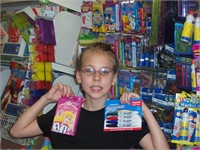
Homeschooling — Getting Started
Important Notice: Our web hosting provider recently started charging us for additional visits, which was unexpected. In response, we're seeking donations. Depending on the situation, we may explore different monetization options for our Community and Expert Contributors. It's crucial to provide more returns for their expertise and offer more Expert Validated Answers or AI Validated Answers. Learn more about our hosting issue here.

Homeschooling — Getting Started
You must be logged in to post a comment.
Homeschooling your child is a wonderful experience for the whole family. It’s one of the best things I have ever done. It truly is a way of life. But, it can be overwhelming, especially at the beginning.
Here are some ideas to help get you started:
1. Use everyday opportunities as learning moments. We all have to run errands, so incorporate “teachable moments” during these times.
For example, the grocery store can be a great place to learn. Kids and food go together. They like to eat, and as fast as they are growing and developing, they need lots of good nutrition. If your kindergartener is struggling with math, get them involved in the shopping. They can count the number of items as you put them in the cart, count the number of cereal boxes, and later, they can begin working with pricing and money related to the groceries.
2. If you try something and it doesn’t work, that’s okay. It just means you discovered something that doesn’t work, so you can cross that off your list and try something else. Thomas Edison made over 1,000 attempts to invent the light bulb before he finally got it right. Instead of getting upset, he said that he didn’t fail 1,000 times; he just simply found 1,000 ways not to make a light bulb. Now that’s what I call being committed to a project!
3. Incorporate things your child really enjoys into learning.
For instance, if your second grader is having trouble with writing, let her pick the subject to write about and don’t stress yourself out over the spelling. A huge learning milestone for students is to be able to get the ideas from their head onto the paper. Even the best young authors have to work at spelling and sentence structure. It will come with time, and it will get better if you stay with it!
If your daughter likes princesses, perhaps she could write a story about herself being the princess in a magical fairyland. Or, your son could write a little piece in which he’s a pirate or race car driver. You can always go back over it with your child later and make corrections.
Have your child write the final copy of the story on big, thick poster board and let them draw or paint a picture to accompany the story. (You can draw lines on the poster board ahead of time to keep it neat.) Share the “finished product” with family members and friends who will enjoy cheering on your child for their hard work.
4. Keep an ongoing portfolio or memory book of your child’s good attempts and successes. It can be as “fancy” or “simple” as you want. Include things such as tests, writing samples, math homework papers, or anything else your child has done that shows improvement and learning. When they, or you, start to feel a bit discouraged, get out this memory book and look at how far you’ve both come. Write little notes to go along with items in the memory book and you will enjoy looking at this in the future. You’ll be surprised by how quickly you can fill up a memory book, and it will give the whole family a wonderful feeling of accomplishment!
Keep it positive and don’t give up. Remember, no one loves your child the way you do. Because you want what is best for your child, you will stay with it, and when the going gets tough, you can rest assured that brighter days in the land of learning are just around the corner!